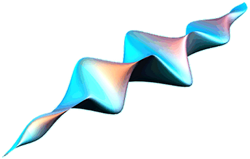The photon
You can think of photons as 'light particles' - quanta of energy - discrete packages (that can't be split)...... little packets of wave energy - wavelets! The image on the right is an artist's view of a photon (a wave packet of energy). Click here to find out more about the artwork. The energy of a photon is proportional to its frequency. E = hfThe constant of proportionality is called the Planck constant. It has the symbol 'h' and is on your data sheet. It has a value of 6.63 x 10 -34 Js
Now, for all electromagnetic radiation the velocity is 'c' (the speed of light - again, you will find this on your data sheet as 3.0 x 108 m/s). Combining this equation with the wave equation we have:
(always write it this way - learn to - it saves time!) Try this question: A 50W lamp radiates in the visible region of the spectrum (400 to 700 nm). Estimate the number of photons produces each second by the lamp. Click here for the answer The momentum of a photonEinstein's equation E = mc2 links mass and energy. That means that mass can be converted into energy and vice versa. We can therefore find the mass equivalent of a photon and then work out its momentum! E = hf = mc2
mphoton = hf/c2 and as the momentum of the photon = mc pphoton = hf/c
f = c/λ
pphoton = h/λThis relationship is important as it links the wave and particle properties of the photon. It expresses wave-particle duality. |
Follow me...
|


 A
quantum of electromagnetic energy is called a photon.
A
quantum of electromagnetic energy is called a photon.


